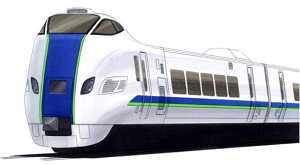KiHa 285 series
| KiHa 285 series | |
|---|---|
|
An artist's impression published in September 2014 | |
| Manufacturer | Kawasaki Heavy Industries |
| Built at | Kobe |
| Constructed | 2014 |
| Number built | 3 vehicles |
| Formation | 3 cars per trainset |
| Fleet numbers | HB-901 |
| Operator | JR Hokkaido |
| Specifications | |
| Car body construction | Stainless steel |
| Track gauge | 1,067 mm (3 ft 6 in) |
The KiHa 285 series (キハ285系) is a tilting diesel multiple unit (DMU) train type developed by Hokkaido Railway Company (JR Hokkaido), originally intended for use on limited express services in Hokkaido, Japan. One three-car trainset was completed in September 2014 by Kawasaki Heavy Industries in Kobe, but plans to construct any further KiHa 285 series trains were cancelled in September 2014, and the trainset built is not expected to used in revenue service.
Design
The KiHa 285 series train uses a new compound tilting system, which tilts the train vehicles by up to 8 degrees using a pendular system (tilt of up to 6 degrees) combined with air suspension tilting (tilt of up to 2 degrees).[1] The train also uses a new motor-assisted ("MA") hybrid diesel traction system, which supplements conventional diesel traction with batteries, inverters, and electric motors.[1] While unspecified, the maximum operating speed and maximum speeds through curves were intended to exceed those offered by existing diesel trains.[1]
Formation
The single three-car set built is numbered HB-901, and formed as shown below.[2]
| Numbering | KiHa 285-901 | KiHa 284-901 | KiHa 285-902 |
|---|
History
Design work for the prototype KiHa 285 series train commenced in April 2011.[3] On 10 September 2014, JR Hokkaido announced that it was terminating development and production of further trains following the completion of one three-car set built by Kawasaki Heavy Industries.[3] The decision was made following reassessments of priorities by JR Hokkaido, with a shift away from focusing on increasing operating speeds to reduce journey time, with a greater focus on safety and maintenance costs through standardization of its diesel fleet.[3] Ageing diesel trains will be instead replaced by KiHa 261 series trains, first introduced in 2000.[3]
The three-car trainset built was delivered from Kawasaki Heavy Industries to JR Hokkaido's Naebo Works in September 2014.[2] After undergoing low-speed testing within the confines of Naebo Works, the three-car set was first test-run on the Hakodate Main Line from 31 October 2014.[4]
Future plans
Following the cancellation of further production, JR Hokkaido is considering how to utilize the single three-car trainset built, including the possibility of converting it for use as a track and overhead wire inspection train.[3]
References
- ↑ 1.0 1.1 1.2 新型特急車両の開発中止について [Cancellation of development of new limited express trains] (PDF). News release (in Japanese). Japan: Hokkaido Railway Company. 10 September 2014. Retrieved 11 September 2014.
- ↑ 2.0 2.1 キハ285系3両が甲種輸送される [Three KiHa 285 series cars delivered]. Japan Railfan Magazine Online (in Japanese). Japan: Koyusha Co., Ltd. 27 September 2014. Retrieved 27 September 2014.
- ↑ キハ285系が本線試運転 [KiHa 285 series test run on main line]. Japan Railfan Magazine Online (in Japanese). Japan: Koyusha Co., Ltd. 1 November 2014. Retrieved 2 November 2014.
| |||||||||||||||||||||||||
